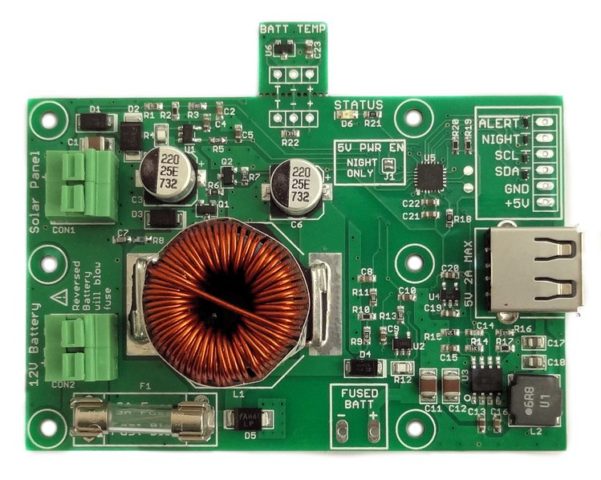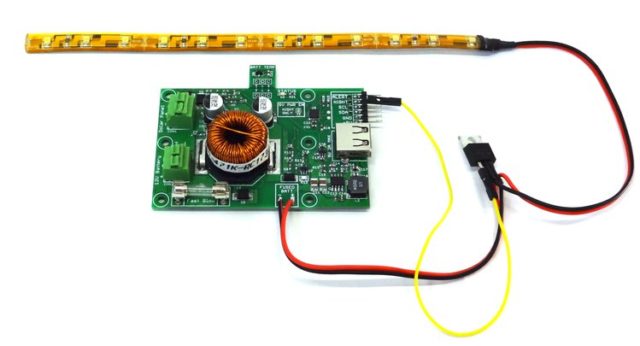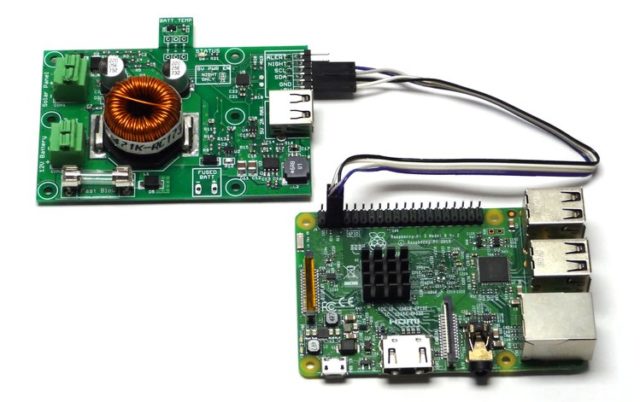Danjuliodesigns llc. A boutique embedded systems design firm run by engineer and inventor Dan Julio has set up crowdfunding for the makerPower Solar power supply/charger for intelligent power supply just about anywhere and in any climate. A comprehensive device structured to IoT and embedded systems, where sometimes a remote camera or other device needs power all the time. The power source is a solar panel which can charge a standard lead-acid battery (USA availability only)
 We reported on a solar input board PiJuice battery HAT and although there are other solar input devices on the market, such as the PiJuice, for use with SBC’s such as Raspberry Pi, the makerPower Solar functions at a higher level, incorporating intelligent power control and functioning. The board can be source powered by solar panel through a standard lead-acid battery, rather than a Li-Po or Li-Ion.
We reported on a solar input board PiJuice battery HAT and although there are other solar input devices on the market, such as the PiJuice, for use with SBC’s such as Raspberry Pi, the makerPower Solar functions at a higher level, incorporating intelligent power control and functioning. The board can be source powered by solar panel through a standard lead-acid battery, rather than a Li-Po or Li-Ion.

The inventor felt a source should carry as much power as possible and the Li-Po or Li-Ion battery would not produce enough power to sustain a wide variety of devices, function in almost all types of climates and overall cost less than other batteries. The solar panel would be a 36-cell, 12V board that produces 5V and up to 2A to run sensors and other devices. There is a maximum power-point transfer converter (MPPT) providing optimal charging through dynamic perturb and observe.

The software includes Arduino libraries and Linux Daemon for configurations other than what is already present, data logging, remote access, and the auto-shutdown/watchdog support, which are optional, but very handy for those windy mountainous terrains. The board can be connected to the solar panel, battery and board as follows –
Specifications
- Dimensions
- 85 x 56 mm (same size as Raspberry Pi 3)
- Mounting holes align with Raspberry Pi boards (including Pi Zero)
- 12 V Operation
- Designed for 36-cell solar panels (typ 25-40 W)
- Works with sealed AGM lead-acid batteries (typ 7-18 Ah)
- 35 W MPPT Charger
- Dynamic Perturb & Observe algorithm
- Three state charge: BULK, ABSORPTION, FLOAT
- Temperature compensation
- Dual Outputs
- 5 V 2 A (10 W) managed output available from USB Type A socket for plug&play with many devices or from a 0.1” header for direct connection
- Fused and current monitored 12 V (3 A maximum) battery output available from a header
- Digital Interface
- I²C slave interface
- Alert logic signal to notify of impending power-down
- Night logic signal asserted when the solar panel is dark
- Detachable temperature sensor for battery temperature monitoring
The single board is going for $40 on Crowd Supply, $75 for the dual-board bundle, and $130 for the entire system: board, wiring kit and a 35W solar panel. The information found here was provided in part by Hackster.io.

Stephen started writing about technology after publishing sci-fi short stories. His first White-Paper, written in 2008, was well received and inspired him to continue writing about technology. Today he writes in the technology space full time, covering a multitude of topics. During the time he wrote part-time he edited hundreds of titles for large publishers, in science and technology. He lives in Staten Island, with his wife and children.
Support CNX Software! Donate via cryptocurrencies, become a Patron on Patreon, or purchase goods on Amazon or Aliexpress





